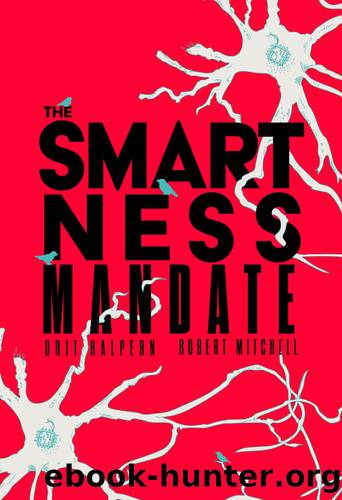The Smartness Mandate by Orit Halpern;Robert Mitchell;

Author:Orit Halpern;Robert Mitchell;
Language: eng
Format: epub
Tags: Neoliberalism; Smart technologies; Smart cities; Artificial intelligence; Machine learning
Publisher: MIT Press
3.1â â â â Black-Scholes model summation. Source: âBlack-Scholes-Merton,â Brilliant.org, https://brilliant.org/wiki/black-scholes-merton/.
While Black and Scholesâs quite technical and seemingly narrow approach meant that they initially encountered problems in finding a publisher for their article, once the piece was published, multiple groups began offering software for such pricing equations.12 This was not least because Black and Scholesâs premises allowed buyers and sellers of options to come to relatively easy agreement on option prices. While it had been difficult to settle on option prices if one assumed that sellers and buyers of options had to agree on the objective health of the company, the only unknown variable of the Black-Scholes option pricing model was the future volatility of the stock, and Blackâs volatility charts allowed sellers and buyers to find common ground here. The success of Black and Scholesâs equation was also in large part a consequence of the fact that the model joined communications and information theories with calculation in a way that made their equation amenable to algorithmic enactment.
As individuals created more complex derivative instruments that tied together many types of assets and markets, computers became essential both for obtaining data about price volatility and for calculating option prices. An entire industry, and the financial markets of today, were born from this innovation and its new understanding of noise. And because derivatives are bets on the future value of an asset, the derivatives markets can beâand in fact areâfar larger than the worldâs current gross domestic product (GDP). (The amount of money at play in the derivatives market currently exceeds the worldâs GDP by 20 times.) Since the 1970s, these markets have grown massively (e.g., 25 percent per year over the last 25 years). In this sense, the derivative pricing equation is indicative of the emergence of a broader new epistemology that transformed conceptions of agency, the agent, and decision-making in the postwar period.
If the Black-Scholes model implied a new model of how to value options on stocks, it also implied a new model of the economic agent. Black and Scholes had begun working together in the late 1960s while consulting for investment firms. Their work involved applying computers to modern portfolio theory and automating arbitrage.13 Scholes and Black began âThe Pricing of Options and Corporate Liabilities,â the article in which they introduced their option pricing equation, with a challenge: âIf options are correctly priced in the market, it should not be possible to make sure profits by creating portfolios of long and short positions.â They reasoned that since people do make money, options therefore cannot be âcorrectlyâ priced, at least in the traditional sense that the option price is a function of an underlying objective value of the stock. Mispricingâthat is, the imperfect transmission of informationâmust be essential to the operation of markets. Noise is the only source of arbitrage.
âRationalâ investing in options thus did not mean attempting to determine the true value of the underlying asset. Because the market is full of noiseâthe market exists, in fact, only because of noiseâthe economic agents
Download
This site does not store any files on its server. We only index and link to content provided by other sites. Please contact the content providers to delete copyright contents if any and email us, we'll remove relevant links or contents immediately.
| American National Standards Institute (ANSI) Publications | Architecture |
| History | Measurements |
| Patents & Inventions | Research |
Whiskies Galore by Ian Buxton(41541)
Introduction to Aircraft Design (Cambridge Aerospace Series) by John P. Fielding(32893)
Small Unmanned Fixed-wing Aircraft Design by Andrew J. Keane Andras Sobester James P. Scanlan & András Sóbester & James P. Scanlan(32580)
Craft Beer for the Homebrewer by Michael Agnew(17938)
Turbulence by E. J. Noyes(7717)
The Complete Stick Figure Physics Tutorials by Allen Sarah(7150)
Kaplan MCAT General Chemistry Review by Kaplan(6606)
The Thirst by Nesbo Jo(6450)
Bad Blood by John Carreyrou(6286)
Modelling of Convective Heat and Mass Transfer in Rotating Flows by Igor V. Shevchuk(6231)
Learning SQL by Alan Beaulieu(6043)
Weapons of Math Destruction by Cathy O'Neil(5853)
Man-made Catastrophes and Risk Information Concealment by Dmitry Chernov & Didier Sornette(5672)
Digital Minimalism by Cal Newport;(5397)
Life 3.0: Being Human in the Age of Artificial Intelligence by Tegmark Max(5198)
iGen by Jean M. Twenge(5170)
Secrets of Antigravity Propulsion: Tesla, UFOs, and Classified Aerospace Technology by Ph.D. Paul A. Laviolette(5005)
Design of Trajectory Optimization Approach for Space Maneuver Vehicle Skip Entry Problems by Runqi Chai & Al Savvaris & Antonios Tsourdos & Senchun Chai(4849)
Electronic Devices & Circuits by Jacob Millman & Christos C. Halkias(4756)
